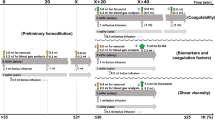Abstract
We studied whether a flow-independent increase of luminal wall shear stress (WSS) could dilate hamster arterioles in vivo and which endothelial mediators are potentially involved. To this end the plasma viscosity was elevated by exchanging blood for dextran-erythrocyte solution thereby augmenting WSS. Diameters of small and large arterioles as well as red blood cell velocities were measured before and after exchange of blood for solutions of identical haematocrit containing either high- (HMWD) or low-molecular weight dextran (LMWD). The potential role of endothelial autacoids was investigated by local application of the NO-synthase inhibitor N G-nitro-L-arginine (L-NNA), the inhibitor of cyclooxygenase, indomethacin (3 μM), or the K+-channel blocker, tetrabutylammonium (TBA, 0.1 mM) to assess the potential effects of EDHF. HMWD (n = 11 animals) increased plasma viscosity by 64 ± 3% and dilated arterioles of all branching orders (A1–A4) significantly [by 24 ± 3% (A1–A2) and 32 ± 3% (A3–A4)]. This dilation compensated fully for the calculated initial increase of WSS. LMWD (n = 6) did not affect plasma viscosity or arteriolar diameters. Tissue treatment with L-NNA (30–300 μM, n = 12) substantially diminished the HMWD-induced dilation in small arterioles (A3–A4; to 13 ± 3%; P<0.05) and virtually abolished it in large ones (A1–A2). Consequently, the calculated WSS increased significantly in these arterioles (by 31 ± 5%). TBA combined with L-NNA (n = 4) did not reduce further the remaining dilation. Indomethacin (n = 6) had no effect on HMWD-induced dilation. We conclude that an increase of WSS induces a mainly NO-mediated arteriolar dilation. This dilation occurs in all arteriolar branching orders and is of sufficient magnitude to compensate for the initial WSS-increase. Thus, any elevations of WSS fulfil the requirement for a signal to change diameter along the arteriolar tree in a coordinated manner. The fully compensating dilation which we observed indicates that WSS is a controlled variable. It does, however, raise questions as to its role as a continuous endothelial stimulus.
Similar content being viewed by others
Author information
Authors and Affiliations
Additional information
Received: 2 August 1996 / Received after revision: 24 February 1997 / Accepted: 14 April 1997
Rights and permissions
About this article
Cite this article
de Wit, C., Schäfer, C., von Bismarck, P. et al. Elevation of plasma viscosity induces sustained NO-mediated dilation in the hamster cremaster microcirculation in vivo. Pflügers Arch 434, 354–361 (1997). https://doi.org/10.1007/s004240050408
Issue Date:
DOI: https://doi.org/10.1007/s004240050408




